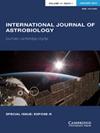Surviving Mars: new insights into the persistence of facultative anaerobic microbes from analogue sites
IF 1
4区 物理与天体物理
Q3 ASTRONOMY & ASTROPHYSICS
引用次数: 3
Abstract
Mars analogue environments are some of the most extreme locations on Earth. Their unique combination of multiples extremes (e.g. high salinity, anoxia and low nutrient availability) make them valuable sources for finding new polyextremophilic microbes, and for exploring the limits of life. Mars, especially at its surface, is still considered to be very hostile to life but it probably possesses geological subsurface niches where the occurrence of (polyextremophilic) life is conceivable. Despite their well-recognized relevance, current knowledge on the capability of (facultative) anaerobic microbes to withstand extraterrestrial/Martian conditions, either as single strains or in communities, is still very sparse. Therefore, space experiments simulating the Martian environmental conditions by using space as a tool for astrobiological research are needed to substantiate the hypotheses of habitability of Mars. Addressing this knowledge gap is one of the main goals of the project MEXEM (Mars EXposed Extremophiles Mixture), where selected model organisms will be subjected to space for a period of 3 months. These experiments will take place on the Exobiology facility (currently under development and implementation), located outside the International Space Station. Such space experiments require a series of preliminary tests and ground data collection for the selected microbial strains. Here, we report on the survivability of Salinisphaera shabanensis and Buttiauxella sp. MASE-IM-9 after exposure to Mars-relevant stress factors (such as desiccation and ultraviolet (UV) radiation under anoxia). Both organisms showed survival after anoxic desiccation for up to 3 months but this could be further extended (nearly doubled) by adding artificial Mars regolith (MGS-1S; 0.5% wt/v) and sucrose (0.1 M). Survival after desiccation was also observed when both organisms were mixed before treatment. Mixing also positively influenced survival after exposure to polychromatic Mars-like UV radiation (200–400 nm) up to 12 kJ m−2, both in suspension and in a desiccated form.幸存的火星:对类似地点兼性厌氧微生物持久性的新见解
火星模拟环境是地球上最极端的环境之一。它们独特的多种极端组合(例如高盐度、缺氧和低营养可用性)使它们成为寻找新的多极端微生物和探索生命极限的宝贵来源。火星,尤其是它的表面,仍然被认为是非常不适合生命的,但它可能拥有地下地质环境,在那里(多极端)生命的出现是可以想象的。尽管它们具有公认的相关性,但目前关于(兼性)厌氧微生物承受地外/火星条件的能力的知识,无论是作为单个菌株还是在群落中,仍然非常稀少。因此,需要利用空间作为天体生物学研究的工具,模拟火星环境条件的空间实验来证实火星可居住的假设。解决这一知识差距是MEXEM(火星暴露极端微生物混合物)项目的主要目标之一,在该项目中,选定的模式生物将在太空中进行为期3个月的研究。这些实验将在位于国际空间站外的外太空生物学设施(目前正在开发和实施中)进行。这种空间实验需要对选定的微生物菌株进行一系列初步试验和地面数据收集。在此,我们报道了Salinisphaera shabanensis和Buttiauxella sp. MASE-IM-9暴露于火星相关应激因子(如干燥和缺氧下的紫外线辐射)后的生存能力。这两种生物在缺氧干燥后都能存活3个月,但通过添加人造火星风化层(MGS-1S;0.5% wt/v)和蔗糖(0.1 M)。在处理前将两种微生物混合,也观察到干燥后的存活率。混合也对暴露于多色火星样紫外线辐射(200-400 nm)高达12 kJ m - 2后的存活产生积极影响,无论是悬浮形式还是干燥形式。
本文章由计算机程序翻译,如有差异,请以英文原文为准。
求助全文
约1分钟内获得全文
求助全文
来源期刊

International Journal of Astrobiology
地学天文-地球科学综合
CiteScore
3.70
自引率
11.80%
发文量
45
审稿时长
>12 weeks
期刊介绍:
International Journal of Astrobiology is the peer-reviewed forum for practitioners in this exciting interdisciplinary field. Coverage includes cosmic prebiotic chemistry, planetary evolution, the search for planetary systems and habitable zones, extremophile biology and experimental simulation of extraterrestrial environments, Mars as an abode of life, life detection in our solar system and beyond, the search for extraterrestrial intelligence, the history of the science of astrobiology, as well as societal and educational aspects of astrobiology. Occasionally an issue of the journal is devoted to the keynote plenary research papers from an international meeting. A notable feature of the journal is the global distribution of its authors.
 求助内容:
求助内容: 应助结果提醒方式:
应助结果提醒方式:


